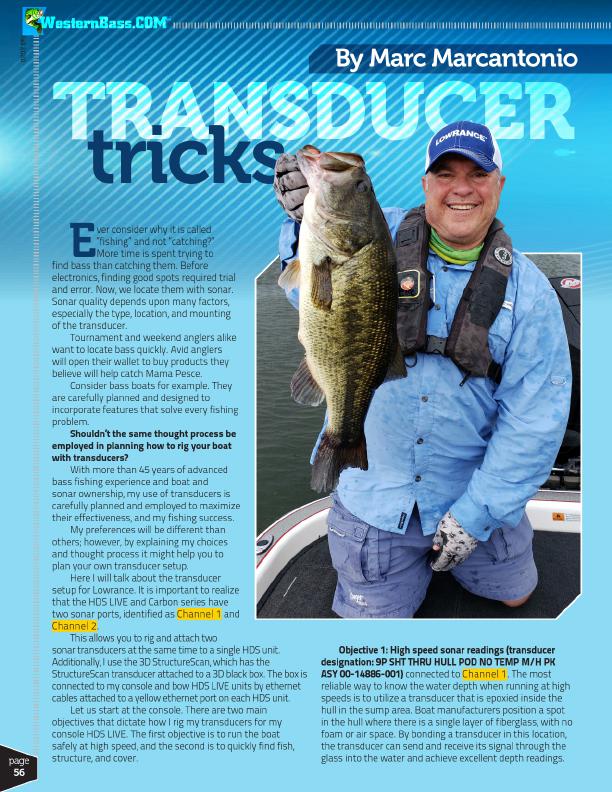
®
®
TRANS D UCER
By Marc Marcantonio
Fall 2020
tricks
page 56
E
ver consider why it is called
“fishing” and not “catching?”
More time is spent trying to find bass than catching them. Before
electronics, finding good spots required trial
and error. Now, we locate them with sonar.
Sonar quality depends upon many factors,
especially the type, location, and mounting
of the transducer.
Tournament and weekend anglers alike
want to locate bass quickly. Avid anglers
will open their wallet to buy products they
believe will help catch Mama Pesce.
Consider bass boats for example. They
are carefully planned and designed to
incorporate features that solve every fishing
problem.
Shouldn’t the same thought process be
employed in planning how to rig your boat
with transducers?
With more than 45 years of advanced
bass fishing experience and boat and
sonar ownership, my use of transducers is
carefully planned and employed to maximize
their effectiveness, and my fishing success.
My preferences will be different than
others; however, by explaining my choices
and thought process it might help you to
plan your own transducer setup.
Here I will talk about the transducer
setup for Lowrance. It is important to realize
that the HDS LIVE and Carbon series have
two sonar ports, identified as Channel 1 and
Channel 2.
This allows you to rig and attach two
sonar transducers at the same time to a single HDS unit.
Additionally, I use the 3D StructureScan, which has the
StructureScan transducer attached to a 3D black box. The box is
connected to my console and bow HDS LIVE units by ethernet
cables attached to a yellow ethernet port on each HDS unit.
Let us start at the console. There are two main
objectives that dictate how I rig my transducers for my
console HDS LIVE. The first objective is to run the boat
safely at high speed, and the second is to quickly find fish,
structure, and cover.
Objective 1: High speed sonar readings (transducer designation: 9P SHT THRU HULL POD NO TEMP M/H PK ASY 00-14886-001) connected to Channel 1. The most reliable way to know the water depth when running at high speeds is to utilize a transducer that is epoxied inside the hull in the sump area. Boat manufacturers position a spot in the hull where there is a single layer of fiberglass, with no foam or air space. By bonding a transducer in this location, the transducer can send and receive its signal through the glass into the water and achieve excellent depth readings.